BY LETTER
Yall-Ull (Gliese 667)
Galactography > Regions of Space > Inner Sphere
Galactography > Systems and Worlds > Systems & Worlds Y - Z
Galactography > Systems and Worlds > Systems & Worlds Y - Z
A triple-star system in the Inner Sphere | |
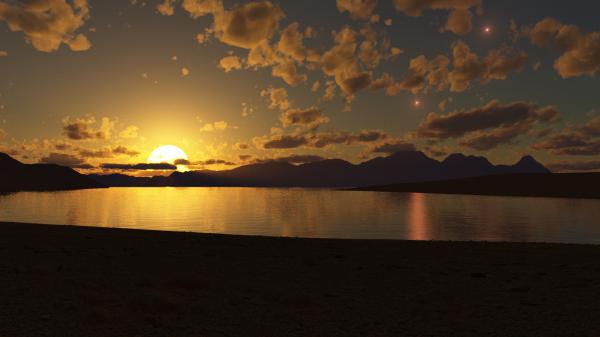 Image from Matthew C. Johnson | |
| The three stars of this system as seen from the surface of the supermundane shell surrounding Malkas | |
Yall-Ull - Data Panel | |
| System | Names: Yall-Ull, Gliese 667 (GJ 667), HD 156384, HIP 84709, HR 6426 Components: 3 1) Yelsal (Gliese 667 A) 2) Tehno (Gliese 667 B) 3) Arcas (Gliese 667 C) Location: - Distance from Guniibuu: 5.244 ly (J2000) - Distance from Sol: 23.873 ly (J2000) - Constellation: Scorpius |
|---|---|
| Yelsal | Names: Yelsal, Gliese 667 A Physical characteristics: - Mass: 0.73 x Sol - Radius: 0.76 x Sol - Spectral type: K3 V - Luminosity: 0.254 x Sol (bolometric) - Temperature: 4,700 Kelvin - Age: 8 billion years System: The two main dwarf planets that orbited around this star at 0.11 and 0.27 AU were restored to pristine conditions after the rise of the restorationist mindset in the system. Others were either taken apart for the construction of swarms of habitats and infrastructures that encircle this star, or rearranged into massive habitat complexes housing up to hundreds of billions of sophonts. |
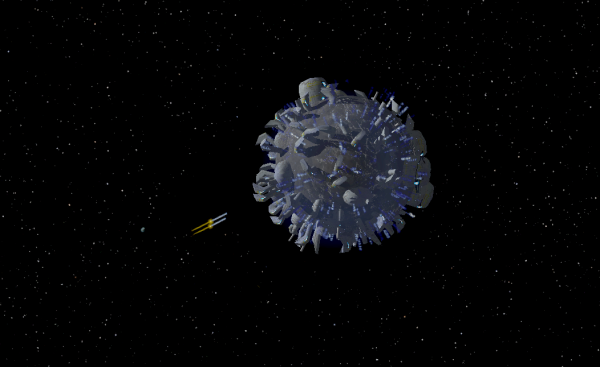 Image from Steve Bowers | |
| The Kbem ecumenopolis | |
| Tehno | Names: Tehno, Gliese 667 B Physical characteristics: - Mass: 0.69 x Sol - Radius: 0.70 x Sol - Spectral type: K5 V - Luminosity: 0.181 x Sol (bolometric) - Temperature: 4,500 Kelvin - Age: 8 billion years System: Kbem, the most massive dwarf planet, orbiting this star at 0.30 AU, is the only major object in the Yall-Ull system that is completely covered in an ecumenopolis. |
|---|---|
| Inner binary orbit | Orbital characteristics: - Average separation: 13.115 AU - Period: 39.86 years - Eccentricity: 0.58 |
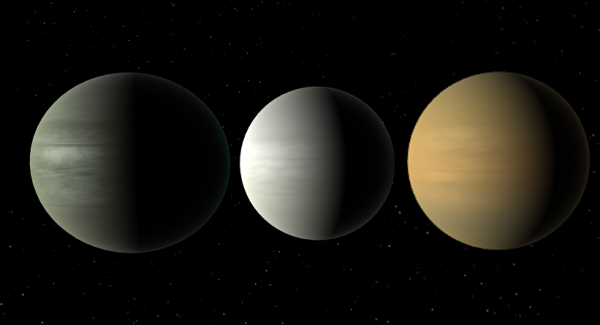 Image from Dangerous Safety, amended by Steve Bowers | |
| The planetary system of Arcas; L'daso, Horvat and Malkas (before the construction of the suprashell around Malkas). | |
| Arcas | Names: Arcas, Gliese 667 C Physical characteristics: - Mass: 0.33 x Sol - Radius: 0.32 x Sol - Spectral type: M1.5 V - Luminosity: 0.017 x Sol (bolometric) - Temperature: 3,700 Kelvin - Rotation period: 105 days - Age: 8 billion years System: 1) L'daso: Acidi-Neptunian Cere-Jotunnian - Semi-major axis: 0.049 AU - Orbital period: 7.200 days - Eccentricity: 0.13 - Mass: 7.5 x Earth - Radius: 2.479 x Earth 2) Horvat: Hydro-Neptunian Cere-Jotunnian - Semi-major axis: 0.121 AU - Orbital period: 28.16 days - Eccentricity: 0.03 - Mass: 5.4 x Earth - Radius: 1.938 x Earth 3) Malkas: Tholi-Neptunian Cere-Jotunnian - Semi-major axis: 0.265 AU - Orbital period: 91.40 days - Eccentricity: 0.08 - Mass: 6.3 x Earth - Radius: 2.381 x Earth This planet is now covered by a habitable suprashell. |
|---|---|
| Arcas binary orbit | Orbital characteristics: - Average separation: 220 AU - Period: 2,467 standard years |
History
The triple system of Gliese 667 was observed to hold three planets orbiting the more distant component, Gliese 667 C. An unmanned interstellar probe was launched in 505 AT to explore this system. By the time the probe reached the system two centuries later Solsys was in the nadir of a Dark Age, and the data sent back by the probe was never received.The system was colonized by the First Federation in 1109 AT. The colony mission was fronted by Clan Yall, a close ally of House Genen. However the planets in this system, L'daso, Malkas and Horvat were not suitable for terraformation, so Clan Yall and their Genen collaborators concentrated on building a wide range of novel and experimental environments inside space habitats in orbit around and between these worlds.
Clan Yall's expertise in ecosystem building was instrumental in the creation of Neo-Helix in the neighboring system; a fact they feel is often ignored when comparing the accomplishments of House Genen families.
The transition between the end of the First Federation and the rise of the megacorporations was a particularly difficult one for this system. Clan Yall experienced extensive in-fighting, that often spilt over into proxy wars involving client populations throughout Yall-Ull. Waves of sectarian radicalization occurred, with anti-transapient and pro-anthropist sentiment becoming entrenched. The entire system became a backwater of sorts for the next millennium.
Yall-Ull returned to the galactic stage in 3901 when it was the chosen neutral site for a conference to negotiate an end to the Conver Wars. While this conference failed to meet the lofty goals set out for it, this initial conference did set the groundwork for the Ian Treaty of 3932. Both the Ambi Limis and the Geminga Orthodoxy remembered this humanitarian effort on behalf of their citizens and retained close ties to the system.
By the Age of Crisis most of the larger habitats had been set aside as nature reserves, and the population had shifted to exclusively living in bubblehabs floating in the atmospheres of these worlds. Numerous coalitions arose at this time, the largest being the colorfully-named Confederation of the Million Floating Eyots.
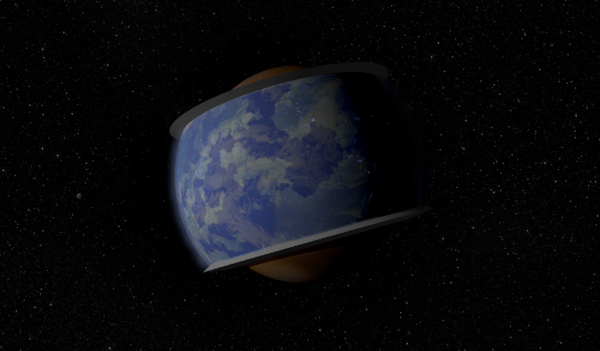 Image from Steve Bowers | |
| The Malkas Suprashell is 17,838 km in radius, and supports an Earthlike environment on the surface. | |
The Malkas Suprashell
In 8077 AT, the Arcas system clan-council began to construct a supramundane shell surrounding the planet Malkas. This structure was completed in 9609. With a radius of 2.8 x Earth, this shell has an surface gravity of 0.81 gees. The shell only covers two thirds of the planet, and is bounded at north and south by a tall atmosphere wall. This shell rotates to give a diurnal period of 25 hours.A significant proportion of the population of the Malkas suprashell are polymorphic in form, switching between different bodyplans at will. A large continent on the northern edge of the suprashell is set aside as a reserve for lazurogened Neanderthals, who are developing their own distinctive culture in this region.
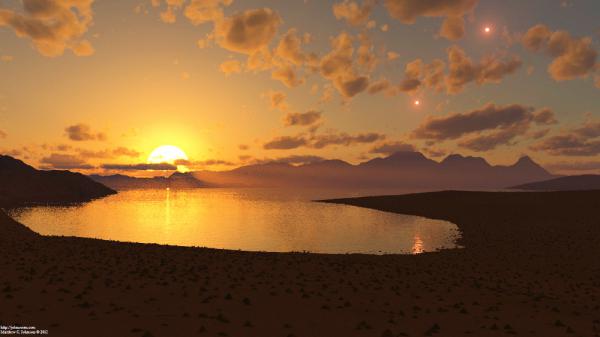 Image from Matthew C. Johnson | |
| The sky above the Malkas suprashell, another view | |
The current population of the Yall-Ull system is cosmopolitan in composition. Of note, the system supports populations of Grays, and Raffins. Together the Raffins and Grays have built a relatively small ecumenopolis, or city world, on the surface of the minor planet Kbem in the Tehno system.
Related Articles
Appears in Topics
Development Notes
Text by Mark Ryherd,
updated by The Astronomer, Dangerous Safety, and Steve Bowers 2020
Initially published on 21 May 2012.
L'daso, Horvat, and Malkas are Gliese 667 C b, C c, and unconfirmed C d, respectively.
Data panel format update (2022-02-21, by The Astronomer)
updated by The Astronomer, Dangerous Safety, and Steve Bowers 2020
Initially published on 21 May 2012.
L'daso, Horvat, and Malkas are Gliese 667 C b, C c, and unconfirmed C d, respectively.
Data panel format update (2022-02-21, by The Astronomer)






